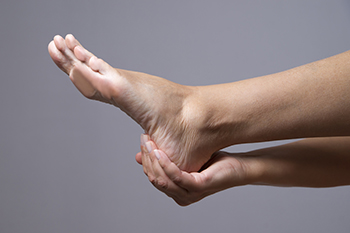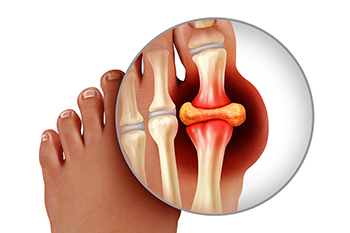Connect With Us
Blog
Items filtered by date: March 2024
Lump in the Foot Arch and Plantar Fibroma
 Plantar fibroma is a benign condition characterized by the formation of a knot or nodule in the arch of the foot. This lump occurs in the plantar fascia, which is a thick band of tissue that runs from the heel to the toes. Typically, someone can feel it if they physically examine the foot. A plantar fibroma can develop in one or both feet, and it usually remains stable in size or grows slowly over time. The lump in the arch may or may not be painful. When pain is present, it's often because the fibroma presses against footwear or the ground, creating pressure on the foot. This discomfort can be increased by standing, walking, or wearing tight or unsupportive shoes. People sometimes modify their gait or posture in an attempt to minimize discomfort, which potentially causes secondary pain in the feet, legs, or back. Treatment options vary depending on the severity of symptoms. Conservative options may include orthotic devices and footwear modifications, and more invasive procedures may involve steroid injections or surgery. If you have a lump in the arch of the foot and suspect a plantar fibroma, it is suggested that you make an appointment with a podiatrist for diagnosis and treatment options.
Plantar fibroma is a benign condition characterized by the formation of a knot or nodule in the arch of the foot. This lump occurs in the plantar fascia, which is a thick band of tissue that runs from the heel to the toes. Typically, someone can feel it if they physically examine the foot. A plantar fibroma can develop in one or both feet, and it usually remains stable in size or grows slowly over time. The lump in the arch may or may not be painful. When pain is present, it's often because the fibroma presses against footwear or the ground, creating pressure on the foot. This discomfort can be increased by standing, walking, or wearing tight or unsupportive shoes. People sometimes modify their gait or posture in an attempt to minimize discomfort, which potentially causes secondary pain in the feet, legs, or back. Treatment options vary depending on the severity of symptoms. Conservative options may include orthotic devices and footwear modifications, and more invasive procedures may involve steroid injections or surgery. If you have a lump in the arch of the foot and suspect a plantar fibroma, it is suggested that you make an appointment with a podiatrist for diagnosis and treatment options.
A plantar fibroma may disrupt your daily activities. If you have any concerns, contact Howard Kimmel, DPM of Buckeye Foot Care. Our doctor can provide the care you need to keep you pain-free and on your feet.
Plantar Fibroma
A plantar fibroma is a fibrous knot in the arch of the foot. It is embedded in the plantar fascia which is a band of tissue that extends from the heel to the toes along the bottom of the foot. There can be multiple plantar fibromas in the feet at the same time. There are no known causes for this condition. If you have a plantar fibroma, there will be a bump in the arch of your foot that cannot be missed. Any associated pain is most often due to a shoe rubbing against the nodule. Non-surgical options, such as steroid injections, physical therapy, and orthotics should be tried first. Surgery is a last resort and is the only thing that will remove a plantar fibroma entirely. Consult with a podiatrist for a proper diagnosis and to determine the treatment regimen that is right for you.
What Causes a Plantar Fibroma?
While there are no specific causes identified, a plantar fibroma can possibly come from genetic predisposition or the formation of scar tissue that forms from healing the tears in the plantar fascia.
What Are the Symptoms of a Plantar Fibroma?
There will be a noticeable lump in the arch of the foot that may or may not cause pain. If pain is felt, it is typically because a shoe is rubbing up against the lump or when walking or standing barefoot.
Treatment and Prevention
A plantar fibroma will not disappear without treatment, but it can get smaller and be a non-issue. If pain persists, a podiatrist examines the foot and when the arch of the foot is pressed, pain can be felt down to the toes. An MRI or biopsy might be performed to help diagnose or evaluate the plantar fibroma. The following non-surgical options are generally enough to reduce the size and pain of these nodules:
- Steroid injections
- Orthotics
- Physical therapy to help apply anti-inflammatory creams on the bump
Surgery is considered if the mass increases in size and the patient continues to feel pain after non-surgical methods are tried.
If you have any questions please feel free to contact one of our offices located in Brook Park, Beachwood, and Willoughby, OH . We offer the newest diagnostic tools and technology to treat your foot and ankle needs.
Various Ways of Testing for Gout

Gout, a painful form of arthritis, often causes intense swelling in a single joint, typically the big toe. Gout is the result of high levels of uric acid in the blood. The uric acid forms crystals in the joints that result in sudden and severe pain, called flare ups. Diagnostic lab tests for gout examine blood or joint fluid for uric acid levels or crystals, though not all cases show elevated uric acid levels. Imaging tests like X-rays, ultrasounds, or special CT scans can help show joint damage or uric acid crystals. Monitoring lab tests can track uric acid levels over time, with additional assessments of kidney function through creatinine and blood urea nitrogen, or BUN, tests. A urinalysis is used to detect uric acid in urine. Regular imaging tests monitor joint health to detect any damage caused by untreated gout. A podiatrist can conduct the appropriate diagnostic tests for gout. If you are experiencing toe joint pain or suspect gout, it is suggested that you schedule an appointment with a podiatrist.
Gout is a painful condition that can be treated. If you are seeking treatment, contact Howard Kimmel, DPM from Buckeye Foot Care. Our doctor will treat your foot and ankle needs.
What Is Gout?
Gout is a form of arthritis that is characterized by sudden, severe attacks of pain, redness, and tenderness in the joints. The condition usually affects the joint at the base of the big toe. A gout attack can occur at any random time, such as the middle of the night while you are asleep.
Symptoms
- Intense Joint Pain - Usually around the large joint of your big toe, and it most severe within the first four to twelve hours
- Lingering Discomfort - Joint discomfort may last from a few days to a few weeks
- Inflammation and Redness -Affected joints may become swollen, tender, warm and red
- Limited Range of Motion - May experience a decrease in joint mobility
Risk Factors
- Genetics - If family members have gout, you’re more likely to have it
- Medications - Diuretic medications can raise uric acid levels
- Gender/Age - Gout is more common in men until the age of 60. It is believed that estrogen protects women until that point
- Diet - Eating red meat and shellfish increases your risk
- Alcohol - Having more than two alcoholic drinks per day increases your risk
- Obesity - Obese people are at a higher risk for gout
Prior to visiting your podiatrist to receive treatment for gout, there are a few things you should do beforehand. If you have gout you should write down your symptoms--including when they started and how often you experience them, important medical information you may have, and any questions you may have. Writing down these three things will help your podiatrist in assessing your specific situation so that he or she may provide the best route of treatment for you.
If you have any questions, please feel free to contact one of our offices located in Brook Park, Beachwood, and Willoughby, OH . We offer the newest diagnostic and treatment technologies for all your foot care needs.
Preventing Hammertoe

If one of your toe joints points upward instead of lying flat, it might indicate a condition known as hammertoe, where weakened toe muscles exert pressure on tendons and joints. This deformity can hinder walking and limit certain activities. Early intervention and preventive measures can help to avoid complications. Hammertoes affect the proximal interphalangeal joint, or PIPJ, causing the middle joint to flex upward. Ill-fitting shoes, especially those with narrow fronts or high heels, commonly trigger this condition. Rheumatoid arthritis or bunions can also contribute. Treatment includes wearing properly sized shoes and using splints or orthotic inserts. Surgery may be necessary for severe cases. Home exercises like toe stretches can help alleviate symptoms. Prioritize footwear comfort to prevent hammertoes and bunions from forming due to prolonged pressure on the toes. If you have a hammertoe that is causing you discomfort, it is suggested that you make an appointment with a podiatrist for an examination and relief methods.
Hammertoe
Hammertoes can be a painful condition to live with. For more information, contact Howard Kimmel, DPM from Buckeye Foot Care. Our doctor will answer any of your foot- and ankle-related questions.
Hammertoe is a foot deformity that affects the joints of the second, third, fourth, or fifth toes of your feet. It is a painful foot condition in which these toes curl and arch up, which can often lead to pain when wearing footwear.
Symptoms
- Pain in the affected toes
- Development of corns or calluses due to friction
- Inflammation
- Redness
- Contracture of the toes
Causes
Genetics – People who are genetically predisposed to hammertoe are often more susceptible
Arthritis – Because arthritis affects the joints in your toes, further deformities stemming from arthritis can occur
Trauma – Direct trauma to the toes could potentially lead to hammertoe
Ill-fitting shoes – Undue pressure on the front of the toes from ill-fitting shoes can potentially lead to the development of hammertoe
Treatment
Orthotics – Custom made inserts can be used to help relieve pressure placed on the toes and therefore relieve some of the pain associated with it
Medications – Oral medications such as anti-inflammatories or NSAIDs could be used to treat the pain and inflammation hammertoes causes. Injections of corticosteroids are also sometimes used
Surgery – In more severe cases where the hammertoes have become more rigid, foot surgery is a potential option
If you have any questions please contact one of our offices located in Brook Park, Beachwood, and Willoughby, OH . We offer the newest diagnostic and treatment technologies for all your foot and ankle needs.
Surgery for Plantar Fasciitis

Plantar fasciitis is characterized by inflammation of the plantar fascia in the feet, leading to extreme pain and limiting daily activities. When conservative treatments fail to provide adequate relief, surgical intervention may become an option. Surgery for plantar fasciitis involves partial release of the plantar fascia from tension and may include removal of heel bone spurs. This procedure is often performed under local anesthesia, with same-day discharge. Post-surgery, patients will undergo a strict recovery regimen. Refraining from strenuous activities for the first month and using supportive footwear and aids such as air casts and crutches may be prescribed by a podiatrist. Regularly changing the dressing is vital to prevent infection. A gradual return to activities may begin after a month, and certain exercises can help to restore foot movements and muscle strength. While tissues may heal within weeks, full recovery from plantar fasciitis surgery typically takes several months. To find out whether surgery for plantar fasciitis is an option for you, it is suggested that you schedule an appointment with a podiatrist to assess treatment choices.
Foot surgery is sometimes necessary to treat a foot ailment. To learn more, contact Howard Kimmel, DPM of Buckeye Foot Care. Our doctor will assist you with all of your foot and ankle needs.
When Is Surgery Necessary?
Foot and ankle surgery is generally reserved for cases in which less invasive, conservative procedures have failed to alleviate the problem. Some of the cases in which surgery may be necessary include:
- Removing foot deformities like bunions and bone spurs
- Severe arthritis that has caused bone issues
- Cosmetic reconstruction
What Types of Surgery Are There?
The type of surgery you receive will depend on the nature of the problem you have. Some of the possible surgeries include:
- Bunionectomy for painful bunions
- Surgical fusion for realignment of bones
- Neuropathy decompression surgery to treat nerve damage
Benefits of Surgery
Although surgery is usually a last resort, it can provide more complete pain relief compared to non-surgical methods and may allow you to finally resume full activity.
Surgical techniques have also become increasingly sophisticated. Techniques like endoscopic surgery allow for smaller incisions and faster recovery times.
If you have any questions please feel free to contact one of our offices located in Brook Park, Beachwood, and Willoughby, OH . We offer the newest diagnostic and treatment technologies for all your foot and ankle needs.

